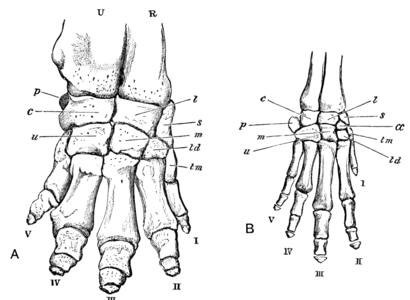Matthew.[1] He has pointed out that in some ancient Ungulates the carpus is not serial but interlocking, even in forms which belong to the earliest Eocene groups, such as the genus Protolambda among the Amblypoda. Now in the fore-foot of Meniscotherium and the living Hyrax there is a separate centrale which is wanting in the greater number of Ungulates. The absorption, that is the practical dropping out of this bone, would restore to an interlocking carpus the serial arrangement; while on the other hand, by the fusion of this bone with the scaphoid, the interlocking disposition would be maintained.

Fig. 112.—Bones of the manus A, of the Indian Elephant, Elephas indicus. × ⅛. B, of the Cape Hyrax, Hyrax capensis. × 1. c, Cuneiform; cc, centrale; l, lunar; m, magnum; p, pisiform; R, radius; td, trapezoid; tm, trapezium; s, scaphoid; u, unciform; U, ulna. (From Flower's Osteology.)
The gradual perfecting of the fore- and hind-limbs as running organs has been put down to the advent of the grasses, and the formation of large plains covered with this herbage. The same reason would also be in harmony with the equally gradual change in the shape of the molar teeth, from a tubercular form calculated for a mixed or even a carnivorous diet, to the flatter crushing surfaces exhibited by the lophodont teeth of later Ungulates. Strong
- ↑ Bull. Amer. Mus. Nat. Hist. ix. 1897, p. 321.
